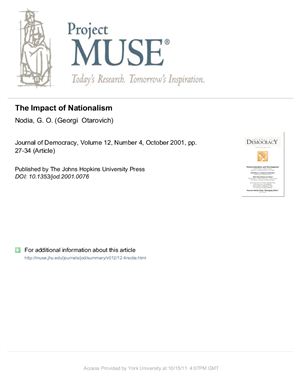Joual of Democracy, Volume 12, Number 4, October 2001, pp.
27-34 (Article)
Observers who comment on the slide toward de-democratization
across much of what used to be the USSR often neglect another
development that is just as interesting: Why is it, just ten years
after all of them were bo from the same Soviet institutional
womb, that these 15 countries have become so different from
one another? Take Estonia and Turkmenistan. The former is a
consolidated democracy with a liberal market economy. It belongs,
or will soon belong, to all the best inteational clubs: NATO, the
World Trade Organization, the Council of Europe, the European
Union, and so on. The latter is run by a dictatorial (though not
very ideological) strongman, and in some respects may be even
farther from democracy than it was at the end of the Brezhnev era.
27-34 (Article)
Observers who comment on the slide toward de-democratization
across much of what used to be the USSR often neglect another
development that is just as interesting: Why is it, just ten years
after all of them were bo from the same Soviet institutional
womb, that these 15 countries have become so different from
one another? Take Estonia and Turkmenistan. The former is a
consolidated democracy with a liberal market economy. It belongs,
or will soon belong, to all the best inteational clubs: NATO, the
World Trade Organization, the Council of Europe, the European
Union, and so on. The latter is run by a dictatorial (though not
very ideological) strongman, and in some respects may be even
farther from democracy than it was at the end of the Brezhnev era.

